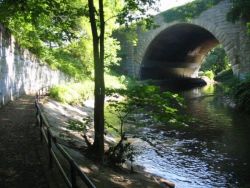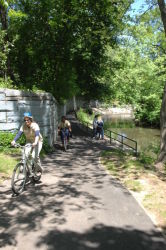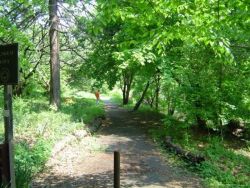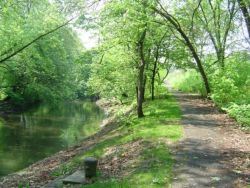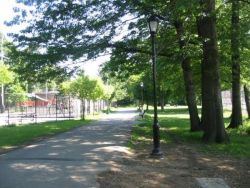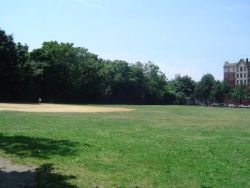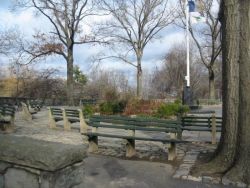Bronx Park
The Daily Plant : Monday, April 1, 2002
EXPLORING PARKS WITH THE URBAN PARK RANGERS
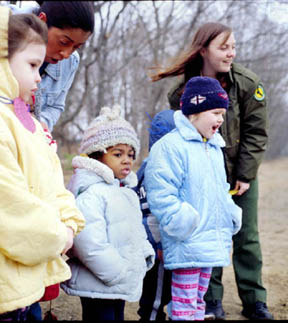
Every weekend in all five boroughs there's a group of nature lovers discovering something new in a park near you. The staff and volunteers in the Urban Park Rangers (UPR) run Explorer Programs all year long, welcoming families, adults and seniors to spend their evenings and weekends getting better acquainted with parks. Developed in conjunction with the National Geographic Society, the programs typically last about an hour and a half and there is no charge for participants.
Hiking or biking with the Rangers is always an adventure – a journey might take you through a forest, around a lake, or through a marsh. On orienteering programs, participants learn how to use a map and compass and then work as a team to navigate in unfamiliar terrain. Aspiring anglers not only learn the basics of catch-and-release fishing, but they also learn about the fish that live in our coastal waters or freshwater ponds and lakes. Although it is illegal for individuals to camp in New York City parks, all are welcome to join the Rangers for a night-time camp-out featuring hikes, storytelling, and stargazing.
Rangers provide expert supervision, as well as running commentary on riverside wildlife, for those who wish to learn basic canoeing techniques. "By far, our most popular program is canoeing," says UPR Deputy Director Matt Symons, "but sometimes it’s proved to be a little more excitement than we were looking for." Two summers ago, Matt and the Bronx Rangers decided to lead a Bronx Parks employee trip before leading a public canoe trip at Orchard Beach. After a great time on the water, they took a lunch break, leaving the canoes at the water's edge. "When we walked back down to retrieve the boats and begin the public tour," Matt reports, "we were greatly pained to find that all but one of the canoes had been gently carried off by the rising tide. That one canoe, that was on its way out, by the way, carried three of us out to rescue the other 5 canoes."
For those looking for a less strenuous way of enjoying parks, the Rangers offer plenty of activities that exercise the mind more than the body. Nature exploration programs give participants the opportunity to trace bird migrations, test water quality, monitor wildlife populations, or examine soil conditions. Rangers and the scientists that work with them often use the data collected on these outings to complement their own research in local ecosystems. Volunteers can make a lasting contribution to the parks they visit by getting involved in an active conservation project. They can help Rangers restore our natural areas by removing invasive plant species from fragile salt marsh habitats, planting native wildflowers to attract birds and butterflies, or monitoring the presence of the wild animals and plants.
Budding artists can express their appreciation for natural beauty during poetry, sketching, and photography workshops as well as Open Mic Nights. Or, let artists, poets, filmmakers, and theatrical groups entertain you at an in-park performance of their work. At lectures, noted experts in their fields will talk about park ecosystems and historical and cultural subjects. A visit to one of the sites operated by Parks or the Historic House Trust might entail a tour, a lecture, a performance, or even a historic craft project. Rangers will tell the stories of the Native Americans, colonists, revolutionaries, and power brokers that have passed through our green spaces.
The development of the Urban Park Rangers program in 1979 helped shape a new understanding of the services Parks could offer. Following a surge of environmentalist movements in the 1960s, the Rangers expanded Parks’ focus to include efforts directed towards preserving parkland and educating the public about New York City's natural resources. Today, twelve citywide Nature Centers provide a base for their educational events, recreational activities and environmental studies. Matt says, "Our goal is to show every New Yorker that there's enough nature and history in our city parks to occupy their weekends for a lifetime."
Find out more about the Urban Park Rangers .
By Jennifer Keeney
THIRTEEN LIGHTYEARS FROM NOW IN THE PLANT
(Monday, April 1, 2015)
LUNAR PARKLAND GETS A BLAST FROM THE PAST
Kids, grown-ups, androids and space-beings looking for an escape from flying taxi congestion and robotic rush hours should catch an AstroShuttle to the moon where Parks just opened its newest out-of-orbit park. Parks officials joined the new Martian Ambassador to cut the ribbon at Lunar Meadows, an 829-acre moon park. "There’s plenty of stuff for every human, beast, human-beast, and cyborg to enjoy," said Parks Robot Relations Director, Skippy 1043.
Lunar Meadows includes a 750-acre moonscaped recreational area, a 42-acre Cloned Dog Run, two brightly colored ShinyBall courts, an electronic turf field, and a colossal anti-gravity play area with CrunchBot-resistant safety surfacing. Topping off the Park’s features is a scale-size holographic double of the Arsenal dubbed the "NeuArsennall" that will serve as a tribute to its Earth-locked archetype. The NeuArsennall, constructed by 10-Boro, hovers 50 feet above the park as a welcoming beacon to visitors, similar to Earth’s yardarms.
QUOTATION FOR THE DAY
"I'd rather be a could-be if I cannot be an are;
because a could-be is a maybe who is reaching for a star.
I'd rather be a has-been than a might-have-been, by far;
or a might have-been has never been,
but a has was once an are."
Milton Berle
Check out your park's Vital Signs
Clean & Safe
Green & Resilient
Empowered & Engaged Users
Share your feedback or learn more about how this park is part of a
Vital Park System

